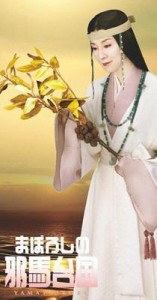
Yoshinaga Sayuri as Himiko in the film 'Moboroshi no Yamataikoku'
In the third century a Chinese envoy wrote of a visit to the land of Wa (as Japan was known). At the time the country was divided into many small states, and he described how one of them called Yamatai was ruled by a shaman-queen called Himiko (or more probably Pimiko). Amongst the customs of the country were polygamy, divination, the wearing of headbands, the clapping of hands during worship, tattooing of fishermen to avoid sea monsters, and the burial of the dead in a small mound with a mourning period of up to ten days. There was little crime, and punishments were severe. But most fascinating of all is the description of the ruler. The state had been ruled by a man previously, but civil unrest over many years prompted the people to turn to a woman. Here is a quotation from the Chinese account:
“She occupied herself with magic and sorcery, bewitching the people. Though mature in age, she remained unmarried. She had a younger brother who assisted her in ruling the country. After she became the ruler, there were few who saw her. She had one thousand women as attendants, but only one man. He served her food and drink and acted as a medium of communication. She resided in a palace surrounded by towers and stockades, with armed guards in a state of constant vigilance.” (taken from Sources of Japanese Tradition)
The account clearly suggests a type of shaman who kept herself pure by remaining unmarried and whose oracular messages were interpreted by her ‘brother‘. Historians see in this a female-male collaboration that was common in ancient times. While the female is possessed by the kami, the male acts as interpreter of the oracle to the wider world. The primacy of the female in Himiko’s time was to give way over time to the authority of the male priest, sanctioned by Confucianism. In this way the female miko (originally a shaman) who spoke with the voice of the kami became relegated to the humble shrine attendant that she is today.
The mystery of Yamatai
The location of Yamatai has long been the subject of controversy: was it in Kyushu, or in Kansai? It’s rather like the quest to locate Arthur’s Camelot in England. In recent years it’s been claimed that Himiko’s grave has been identified. The burial place is known as Hashihaka, just fifteen minutes walk from Hibara Jinja near Omiwa (https://www.greenshinto.com/2011/08/11/hibara-jinja-and-amaterasu/). It has been dated from between 240 and 260 which would fit in perfectly with Himiko’s dates.
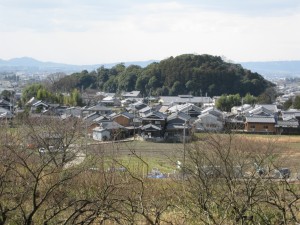
Hashihaka burial mound seen from below Hibara Jinja
Hashihaka has a keyhole shape and is the eleventh longest burial mound in Japan. According to the Nihonshoki, it’s the grave of a daughter of Sujin who committed suicide by stabbing herself in the genitals with a pair of chopsticks – hence the name (hashi means chopsticks, haka is grave). It’s a lurid story that has to do with her uncovering a snake-kami in her boudoir: the mythological equivalent of a tabloid sensation. The imperial household supports the identification and hence the mound cannot be excavated because it would disturb an imperial ancestor. Himiko on the other hand is not an imperial ancestor – which may explain the mystery as to why she doesn’t rate a single mention in the Kojiki or Nihon shoki. How very intriguing!
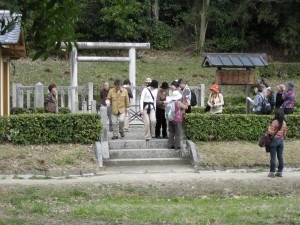
The front of Hashihaka (Himiko's grave?)
When I visited the mound, a group of Japanese were being given a talk. I was only able to catch the end of it, namely that Himiko could have been head of a clan that came into Japan from Korea searching for metals and trade opportunities. It makes me think she could have brought Korean shamanism in with her (fear of unearthing Korean connections is supposedly a strong motivation of the imperial ban on excavating).
Not far from the tumulus is an archaeological site with claims to have been Himiko’s palace. I went in search of it, full of anticipation at seeing where the legendary shamaness may have once lived. But all I could find was a bare patch of land next to a single line rail track, looking like an empty rice field. A local assured me it was indeed the right place. Which just goes to show the virtue of leaving things to the imagination, for reality by contrast can be soooooo disappointing….
Tall white heron
Squawking with surprise –
Spring warmth
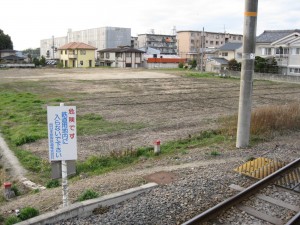
Eh? That's it?? A bare patch of land next to Makimuku railway station said to be the site of Himiko's palace
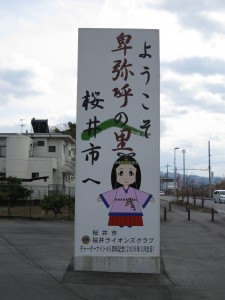
Welcome to Himiko country says a sign at Sakurai city, where the authorities have been quick to capitalise on the potential
More information about the archaeologists’ view of the matter on the excellent Heritage of Japan site….
http://heritageofjapan.wordpress.com/yayoi-era-yields-up-rice/the-advent-of-agriculture-and-the-rice-revolution/who-was-queen-himiko/the-yamatai-puzzle-where-was-himikos-headquarters/could-the-hashihaka-burial-mound-in-sakurai-nara-be-queen-himikos/

On the front page of the heritage of japan website is this:
http://heritageofjapan.wordpress.com/
Newly discovered remains of possible palace ruins advances theory that Makimuku structure may have been Queen Himiko’s palace and centre of Yamataikoku
Featured in today’s and yesterday’s news reports, is the new discovery of the ruins of a possible palace structure at Makimuku, Sakurai, Nara Prefecture. The finding bolsters the theory that the earlier discovered nearby Hashihaka keyhole-shaped tomb may be Queen Himiko’s….see Mainichi report below for details. The Daily Yomiuri also carries the same news (3rd-century structure unearthed in Nara Pref. (Nov 12)) and has the additional information that “Earthenware items produced in various regions from Kanto to Kyushu have been unearthed there” as well as “Each pillar is about 32 centimeters in diameter. It is likely that the structure had an elevated floor.” Japan Times also covers the news – see Japan Times: Dig in Nara, not Kyushu, yields palatial ruins possibly of Himiko.
Recently excavated remains at the Makimuku ruins in Sakurai, Nara Prefecture, might once have been a palace.
***
Remains of large structure unearthed at Makimuku ruins in Nara
The Makimuku ruins, where the remains of the structure were discovered, are pictured in Sakurai, Nara Prefecture on Nov. 5 in this photo taken from a Mainichi helicopter. (Mainichi)
SAKURAI, Nara — The remains of a major structure from the third century — corresponding with the period in which the ancient Japanese queen Himiko lived — has been unearthed at the Makimuku ruins here, the Sakurai Municipal Board of Education has announced.
The Makimuku ruins are believed to be the most likely location of the Yamataikoku kingdom that is associated with Himiko. Education board officials said that holes for pillars, extended 19.2 meters from north to south and 6.2 meters from east to west in an organized fashion, making it one of the largest buildings from the period.
The newly discovered structure was designed to be symmetrical along a line running from east to west, lining up with three structures and a barrier line that were confirmed during past digs, and there is a possibility it was the palace of Himiko. The find is likely to advance the theory that Himiko’s realm was in the Yamato Province in the present-day Kinki region.
Hironobu Ishino, head of the Hyogo Prefectural Museum of Archeology, said the find was a strong basis for concluding that the Yamataikoku kingdom was located at the site of the Makimuku ruins.
“The building is of a size unparalleled for the same period. It is too big for a dwelling,” he said, adding that it probably corresponded to the “palace” of Himiko mentioned in ancient Chinese historical records.
In 1978 a barrier and remains of a building were found, and starting from the point of these discoveries, and expanded survey was launched in February this year. The remains of a large building were later found in an eastern part of the site.
The postholes at the newly discovered site were about 30 centimeters in diameter and were spaced at 4.8-meter intervals from north to south and were 3.1 meters apart from east to west. There were also small holes between the postholes running from east to west that were used to support floorboards.
It is believed that the structure had a total floor space of about 238 square meters, about 1.5 times bigger that the main shrine at the Yoshinogari archeological site in Saga Prefecture, thought to be one of the biggest moat-surrounded settlements during the Yayoi Period.
No earlier sites in which structures have been placed in a symmetrical east-west layout have been uncovered. The features of the structure are similar to those of palaces of the Asuka period (around the seventh century), and there is a high possibility that it was part of the center of a kingdom.
Queen Himiko is believed to have died around 248.
(Mainichi Japan) November 11, 2009
Yes, you are right about the Makimuku ruins. It may be the discovery of the century. Let’s hope Japan will allow more excavations in the future.
too much japanese state mythology. it’s completely wrong to think of Kojiki as of description of some true ancient items; Kojiki was written in 7 – 8 centuries, it desribes the items of that epoch correspondently epoch but not real items of “legendary antiquity” which was quite misunderstood for the authors of Kojiki as well as for us. there were no Japanese imperial dynasty in the time of Yayoi and early Kofun so all so called Sujin/Ojin and even Jimmu are nothing but a fake. while Pimiko/Himiko is real since we have recording of her in Chinese history. and Pimiko really was an ancestor of clan that later became “tenno clan”; as far as Yamato is just pervertion of the word Yamatai. and Pimiko has no relation to Korea/Mongolia; she was Ainu as well as all Yamatai aristocracy.
Thank you for the input, Tresi. The idea that Pimiko was Ainu is intriguing, but I wonder if she was an ancestor of the Yamato clan why she should have been left out of the Kojiki. To me, it makes more sense if she was not an ancestor of the imperial family but from a rival lineage (such as Ainu, if we suppose the Yamato to be derived from Korean/Chinese immigrants). That would make the mystery of her disappearance from Japanese records quite understandable.
I personally believe she was a human INCARNATION of Amaterasu, and therefore the Japanese Imperial Family IS descended from the Sun Goddess, as the Showa Mikado actually NEVER said that he wasn’t descended from Amaterasu, (all Japanese were/are considered descendants of various Kami, anyways, and it was completely hypocritical of the U.S. government to supposedly “force him to renounce his divinity”, and NOT force extremist evangelicals to renounce their “we-have-the-only-true-road-to-salvation, especially because they were a huge reason Japan was being anti-Western), & as for proof:
http://en.wikipedia.org/wiki/Humanity_Declaration#Interpretation,
http://www.bbc.co.uk/religion/religions/shinto/history/emperor_1.shtml,
…&…
a certain quote from another site:
“It should, however, be noted that immediately after this explicit repudiation of divinity, he implicitly reaffirmed it by asking the occupation authorities for permission to worship an ancestress and then worshipping the Sun Goddess; this reaffirmation would have been comprehensible to all Japanese though not necessarily by the occupation authorities.”
Source:
http://www.jref.com/history/emperor-hirohito/
Also, could she not have had BOTH Korean/Chinese, and Ainu heritage?!
Just a thought!!
Thanks for the thought! You don’t address the issue of why Himiko is not mentioned in the Kojiki, particularly if according to your theory she was an incarnation of Amaterasu. The only explanation that makes sense to me for leaving out such an important figure is that she belonged to a completely different clan (a different ‘country’ indeed) from the Yamato imperial lineage.
If Himiko & the Japanese Imperial Family are from COMPLETELY DIFFERENT lineages, then how do you explain the extremely close name similarities between YAMATO, & YAMATAI?!
I highly doubt that the Imperial Family would adopt the namesake of a lineage that they were hostile to, & the story could have been revised, & came out as the version we have today, due to the extraordinarily long amount of time in between, although I’m still convinced that the Imperial Family IS descended from an INCARNATION of Amaterasu!!
Good day and thank you for your input. You make two separate points, heavily backed by exclamation marks though little evidence…
First, regarding the names of Yamato and Yamatai, the similarity is striking but not unlikely in a land of mountains. The similarity may be of the order of Sussex, Wessex and Essex for example… It would be an unfounded assumption to presume the kingdoms are the same simply on the linguistic evidence, and we have to look to archaeological evidence. Experts remain divided on that score.
As regards your second point, I’m not clear about the thinking behind your comment. The Yamato leaders did in fact adopt the gods and lineage of their enemies into their pantheon, one obvious example being that of Izumo. Indeed, pacifying the spirits of angry enemies was a primary concern, and integrating the founding ancestor of Izumo into Yamato mythology was very much a part of the imperial undertaking.
Finally, I’m not sure what you mean by an incarnation of Amaterasu.. are you suggesting that there the sun goddess manifested itself in human form, much as God is supposed to have manifested in Jesus? If so, that would place you as a believer in imperial divinity who belongs to prewar Japan and the time of State Shinto.
To the 1’st 2 points, well, fair enough, & as for the 3’rd point, what I mean is that the Yamato Imperial Family is descended from an incarnation of Amaterasu, without necessarily being incarnation(s) of her themselves!!
Even today, all Japanese are considered descendants of various groups of Kami, (in fact, Shinto ascribes spiritual/divine connections to pretty much EVERYTHING), & Amaterasu is 1 of the most preeminent Shinto Kami!!
Thank you for your clarification. I’m not sure all Japanese are descendants of kami – those lineages which descended from ‘heaven’ with Ninigi no mikoto are specified by name and are therefore special. But the areas into which these ‘Yamato’ folk later moved contained people who were not kami descended, surely. The story of their conquest is told in Kojiki, particularly in the Jimmu and Yamato Takeru myths. Later of course there were the Kumaso, the Emish and the Ainu…
Also, isn’t it possible that Himiko had BOTH Manchurian/Korean/Chinese heritage, IN ADDITION TO AINU?!
I guess all things are possible as regards Himiko, since no one knows for sure…
The Japanese genetic profile is ( as a generalization): 55% Chinese (Han), 35% Ainu and 10% Tungistic/Mongol. Which is interesting as the grammar is basically Tungistic/Mongol, the vocabulary is Chinese and Proto-Mongol and the writing system is Chinese (Imported), while the culture is probably Ainu.
Thank you, Brian, for your interesting input. Your genetic profile is different from the one I’ve seen, which was used by NHK, and which seem to allocate roughly a third to the Chinese and a third to Korean with a third mixed Ainu/Micronesian/et al. I’d be interested to know where your information comes from. The 10% for Tungustic/Mongol seems strangely low, considering all the cultural input. You yourself mention Tumuli and grammatical influence, and then there’s the shamanism and also the Mongol blue spot (do Chinese han have that?} Claiming the culture as Ainu seems a sweeping generalisation; there’s just as much evidence to say the culture is predominately Chinese.
PS: I forgot to mention that the religion is also an Ainu/Chinese mix (Shinto/Bhuddism)!
But the Tumuli are classical Imperial Mongol